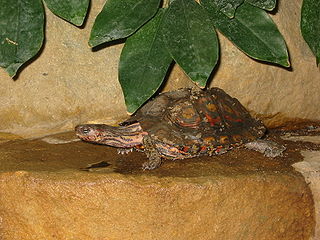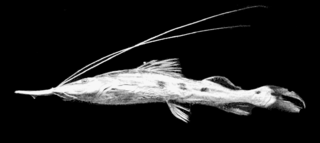
Weasels are mammals of the genus Mustela of the family Mustelidae. The genus Mustela includes the least weasels, polecats, stoats, ferrets, and European mink. Members of this genus are small, active predators, with long and slender bodies and short legs. The family Mustelidae, or mustelids, is often referred to as the "weasel family". In the UK, the term "weasel" usually refers to the smallest species, the least weasel (M. nivalis), the smallest carnivoran species.
Genus is a taxonomic rank used in the biological classification of living and fossil organisms as well as viruses. In the hierarchy of biological classification, genus comes above species and below family. In binomial nomenclature, the genus name forms the first part of the binomial species name for each species within the genus.

In taxonomy, binomial nomenclature, also called binominal nomenclature or binary nomenclature, is a formal system of naming species of living things by giving each a name composed of two parts, both of which use Latin grammatical forms, although they can be based on words from other languages. Such a name is called a binomial name, a binomen, binominal name, or a scientific name; more informally it is also historically called a Latin name.

Columbidae is a bird family consisting of doves and pigeons. It is the only family in the order Columbiformes. These are stout-bodied birds with short necks and short slender bills that in some species feature fleshy ceres. They primarily feed on seeds, fruits, and plants. The family occurs worldwide, but the greatest variety is in the Indomalayan and Australasian realms. The family contains 344 species divided into 50 genera. Thirteen of the species are extinct.

Starlings are small to medium-sized passerine birds in the family Sturnidae. The Sturnidae are named for the genus Sturnus, which in turn comes from the Latin word for starling, sturnus. Many Asian species, particularly the larger ones, are called mynas, and many African species are known as glossy starlings because of their iridescent plumage. Starlings are native to Europe, Asia, and Africa, as well as northern Australia and the islands of the tropical Pacific. Several European and Asian species have been introduced to these areas, as well as North America, Hawaii, and New Zealand, where they generally compete for habitats with native birds and are considered to be invasive species. The starling species familiar to most people in Europe and North America is the common starling, and throughout much of Asia and the Pacific, the common myna is indeed common.

The Geoemydidae are one of the largest and most diverse families in the order Testudines (turtles), with about 70 species. The family includes the Eurasian pond and river turtles and Neotropical wood turtles. Members of this family are commonly called Leaf turtle.
In biology, a monotypic taxon is a taxonomic group (taxon) that contains only one immediately subordinate taxon. A monotypic species is one that does not include subspecies or smaller, infraspecific taxa. In the case of genera, the term "unispecific" or "monospecific" is sometimes preferred. In botanical nomenclature, a monotypic genus is a genus in the special case where a genus and a single species are simultaneously described. In contrast, an oligotypic taxon contains more than one but only a very few subordinate taxa.

In zoological nomenclature, a type species is the species name with which the name of a genus or subgenus is considered to be permanently taxonomically associated, i.e., the species that contains the biological type specimen. A similar concept is used for suprageneric groups and called a type genus.

Suina is a suborder of omnivorous, non-ruminant artiodactyl mammals that includes the domestic pig and peccaries. A member of this clade is known as a suinan. Suina includes the family Suidae, termed suids, known in English as pigs or swine, as well as the family Tayassuidae, termed tayassuids or peccaries. Suines are largely native to Africa, South America, and Southeast Asia, with the exception of the wild boar, which is additionally native to Europe and Asia and introduced to North America and Australasia, including widespread use in farming of the domestic pig subspecies. Suines range in size from the 55 cm (22 in) long pygmy hog to the 210 cm (83 in) long giant forest hog, and are primarily found in forest, shrubland, and grassland biomes, though some can be found in deserts, wetlands, or coastal regions. Most species do not have population estimates, though approximately two billion domestic pigs are used in farming, while several species are considered endangered or critically endangered with populations as low as 100. One species, Heude's pig, is considered by the International Union for Conservation of Nature to have gone extinct in the 20th century.

The Pimelodidae, commonly known as the long-whiskered catfishes, are a family of catfishes.
Propimelodus is a genus of South American catfish of the family Pimelodidae.

Platystomatichthys sturio is the only species in the genus Platystomatichthys of the catfish family Pimelodidae. It is sometimes called the sturgeon catfish. This species occurs in the Amazon Basin and reaches a length of about 40.0 centimetres (15.7 in) TL. Platystomatichthys is classified under the "Calophysus-Pimelodus clade". Within this clade, it is considered a part of the "Pimelodus-group" of Pimelodids, which also includes Pimelodus, Exallodontus, Duopalatinus, Cheirocerus, Iheringichthys, Bergiaria, Bagropsis, Parapimelodus, Platysilurus, and Propimelodus.

Bagropsis reinhardti is a species of long-whiskered catfish. This species reaches about 22.7 cm (8.9 in) in standard length and is endemic to Brazil where it is found in the Das Velhas River basin in São Francisco River drainage. It is considered a threatened species by Brazil's Ministry of the Environment.
Exallodontus aguanai is a catfish species of the monotypic genus Exallodontus of the family Pimelodidae. This genus and species was described in 1991. This species reaches 20 centimetres (7.9 in) SL. This species is native to the Amazon and Orinoco River basins of Brazil, Colombia, Peru and Venezuela. Exallodontus is classified under the "Calophysus-Pimelodus clade". Within this clade, it is considered a part of the "Pimelodus-group" of Pimelodids, which also includes Pimelodus, Duopalatinus, Cheirocerus, Iheringichthys, Bergiaria, BagropsisParapimelodus, Platysilurus, Platystomatichthys, and Propimelodus.
Duopalatinus is a small genus of long-whiskered catfishes native to South America.

Platysilurus is a genus of long-whiskered catfishes native to South America.

Kinixys is a genus of turtles in the family Testudinidae. The genus was erected by Thomas Bell in 1827. The species in the genus Kinixys are native to Sub-Saharan Africa and Madagascar and commonly known as hinged tortoises or hinge-back tortoises.
Bergiaria platana is a species of long-whiskered catfish endemic to Argentina where it occurs in the Paraná River basin. This species grows to a length of 9.1 centimetres (3.6 in) SL.
Bergiaria westermanni is a species of long-whiskered catfish native to the Das Velhas River basin in Brazil as well as being reported to occur in Argentina and Uruguay. This species grows to a length of 19.7 centimetres (7.8 in) SL.

In biology, taxonomic rank is the relative level of a group of organisms in an ancestral or hereditary hierarchy. A common system of biological classification (taxonomy) consists of species, genus, family, order, class, phylum, kingdom, and domain. While older approaches to taxonomic classification were phenomenological, forming groups on the basis of similarities in appearance, organic structure and behaviour, methods based on genetic analysis have opened the road to cladistics.












